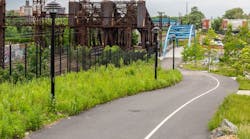Melissa Lanzara is a senior storm water inspector for Parker Design Group. Lanzara can be reached at [email protected].
Sediment is a pollutant that is displaced by rain and carried as storm water runoff to our rivers and streams. Construction sites strip the topsoil that helps to infiltrate runoff and therefore increases the risk of erosion. The grading and moving of soils on construction sites make these locations particularly at risk to discharge sediment.
Sediment control on construction sites became a main area of concern following the Clean Water Act amendments of 1972. Sediment control is the practice to minimize the movement of sediment by use of temporary and permanent controls. Erosion control is the act of minimizing the risk of erosion such as providing stabilization. If you manage erosion as a first step it helps to decrease the demand of maintenance of sediment controls. There have been studies into cost analysis about the savings that can occur if you practice good erosion control.
On a job site some common sediment control practices include the perimeter silt fence, check dams, diversions, sediment traps/basins and outlet protection. All of these controls and more play a vital role in sediment control. But what if they are installed late or skipped all together? The construction sequence and storm water and erosion and sediment control plans are prepared to help minimize this risk. As we all know, construction sites are on a strict timeline and budget. The grading contractor may be pushed to have the site pad ready by a certain date not leaving much time to install these important measures. It is critical to put the installation of these controls as a top priority to ensure that the sediment remains on site. If these measures are overlooked, the project could be at risk of discharging off site, failing inspections, stop work orders or fines. These enforcement procedures cause an impact on the timeline if the job is shut down.
A new project is about to break ground and the pre-construction meeting is being held with responsible land disturbers, owners, municipalities, engineers and consultants. One item that is almost always pointed out but not always followed is the construction sequence. The construction sequence normally looks something like this:
- Contact municipality prior to beginning any land disturbance.
- Host pre-construction meeting.
- Install all perimeter controls prior to begging any upslope land disturbance.
- Install sediment traps/basins.
- Begin grading of site.
- Stabilize site before converting the BMPs to permanent configuration.
Some municipalities require an initial inspection to ensure sediment controls are installed prior to beginning land disturbance. However, some municipalities do not, and this step gets put on the back burner. Ensuring that these controls are installed prior to beginning work can save the site a big headache. In the event some of these controls are skipped and earthwork begins, the site could be at a huge risk of discharge.
One item that is often not thought about in initial control is stabilization. Earthern structures, such as traps, basins and diversions, require immediate stabilization. This will help to reduce the erosion potential of these structures and therefore reduce the impact to the sediment controls downslope. Many states’ regulations differ for how quickly you have to stabilize denuded soils so be sure to check your local regulations.
The sequence of construction also addresses stabilizing the site within a certain timeframe once final grade is achieved. This can help reduce the need for maintenance of permanent structures and also aid in getting the project closed out quickly.
Example Scenario
Construction has kicked off on a job site but the project is under a strict timeline. The contractor begins working upslope simultaneously while building the sediment basin. Weeks pass and the sediment basin no longer becomes a priority and the concentration is elsewhere. A rain event occurs and inches fall in the matter of a couple hours. The sediment basin was not completed and did not have the stabilization or capacity that was needed for this storm. This overwhelmed the pond and caused the embankment to fail. The failing embankment allows sediment to leave the limits of disturbance and enter a neighboring pond.
This loss of sediment must be reported to the enforcement agency. This site was subject to fines for discharging into state waters and the sediment outside of the limits of disturbance must be retrieved by hand which caused delays.
The importance of erosion and sediment control continues to be a top priority at job sites. Spending the time and resources to ensure that these measures are installed correctly and timely can save the project money and time in the long run. With climate change and increasing intensity and duration of storms, these controls continue to be vital to the success of the project. Do not be caught without your initial controls installed and do your future self a favor by installing these critical controls.






